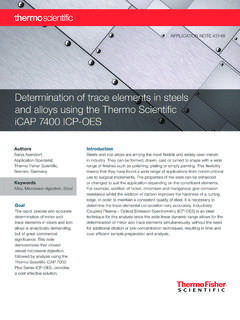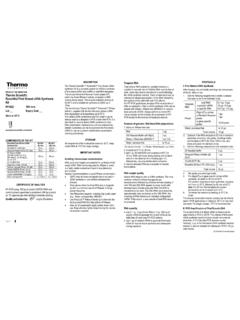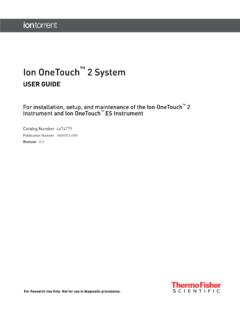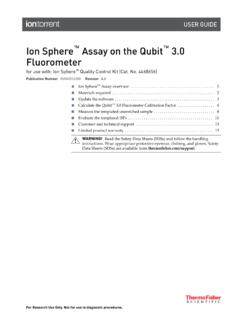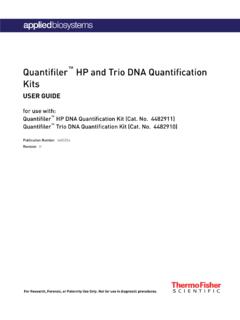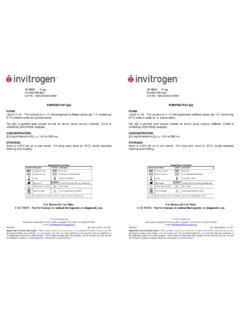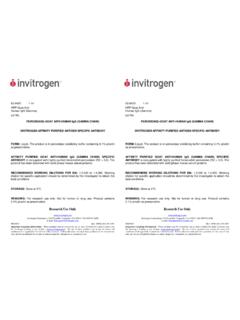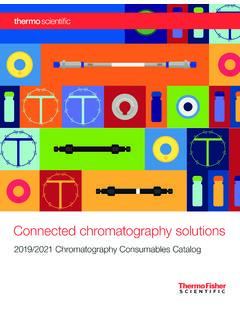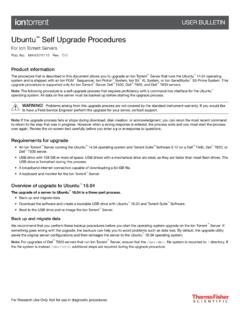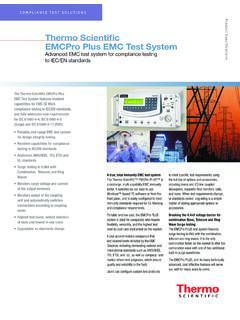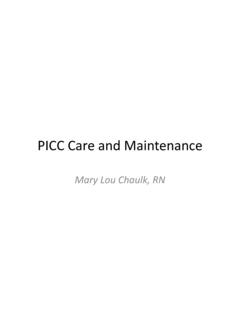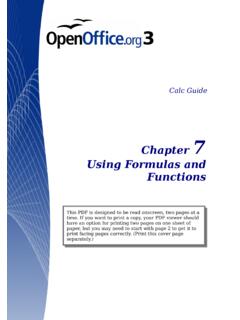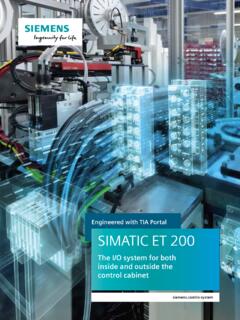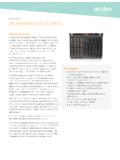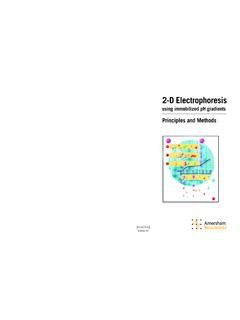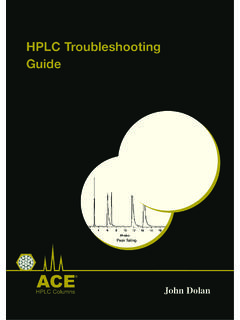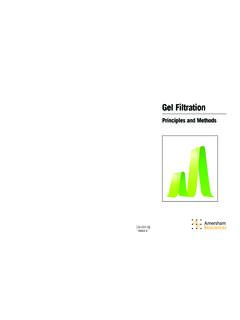Transcription of Ion Chromatography Troubleshooting Guide
1 Ion Chromatography Troubleshooting GuideResolving IC analysis issuesDetectors and detectionElectrolytic suppressionPumps, eluent delivery, and pressureElectrolytic eluent generationRetentionPeak shapeSelectivitySample injection28761345 Resolving IC analysis issuesIon Chromatography (IC) is the premier technique for determining ionic compounds in solution. The basic components consist of an eluent source, pump, sample injector, separating column, suppressor, and detector. As with any lab instrumentation, your IC system should be serviced regularly to ensure peak performance. If problems arise that are not addressed by routine maintenance, this Troubleshooting Guide provides you with suggested solutions so you can quickly resume generating the accurate, reliable data that Thermo Scientific Dionex IC systems are known for.
2 2 Common IC Issues(Click on number to jump to section)Thermo Scientific Dionex ICS-6000 HPIC systemSample injectionEnsure injection-valve materials are compatible with eluent conditions before use. If possible, filter all standards and samples before injection, and ensure that the sample syringe is free of bubbles before sample loading. If possible, use suction to draw sample into loop to avoid contamination or carryover from syringe. SymptomSolutionNo peaksCheck that the injector valve is plumbed correctly and is switching correctly. If using an autosampler, check for trapped air bubbles, check correct location of samples and wash solutions, and check that sampling needle is reaching the sample. Check needle tip for damage and ensure needle is aligned properly with the injection port and is not leaking. For dual systems sharing an autosampler, check the injection valve configuration and ensure the correct valve is switching.
3 Poor injection precisionEnsure use of factory recommended autosampler settings and that the injection valve waste line is routed as recommended in the manual. Check sample transfer line calibration. Check syringe operation and replace, if necessary. As above, check the autosampler operation, and check for air bubbles. Check and wash the rotor and seals, replacing if necessary. For manual injection, leave the needle in the needle port while switching the valve to inject. Check the stability of the sample and carryoverCheck the sample and standard compatibility with eluent and for signs of sample precipitation. Flush the injection loop with up to 10 volumes of sample before injection. For problematic (viscous) samples, dilute further if possible. Reduced or reducing peak heightsCheck for adsorption, precipitation, or evaporation of sample or sample components within sample vial or connecting tubing.
4 Carry out the above maintenance procedures to ensure correct valve operation. Excessive pressure and pressure spikes during injectionConfirm that the valve is switching quickly and smoothly. Ensure that the valve and loop are free from salt deposits and signs of precipitation. Wash (sonicate) or replace rotor, seals, and loop as necessary. Leaking injectorMay be caused by a worn or scratched injector valve rotor or a damaged injector rotor and needle seals. Remove each, wash, check, and replace if necessary. 13 Back to instrument imageRetentionIn IC, analyte retention is dependent upon eluent strength and, for weak anion and cation exchangers, pH. Variation in retention is generally the result of eluent preparation errors or pump retention timesColumn usage can affect capacity. Reproduce the production test chromatogram using conditions noted on the Quality Assurance Report that was shipped with the column to assess column performance.
5 If capacity has been lost, attempt column regeneration per the manufacturer s recommendations or replace the column. Check the eluent concentration. Irreversible adsorption of highly charged species from samples will reduce available capacity. Check the sample for potential sources of column fouling. Use IC sample preparation to minimize matrix effects and prevent column fouling. Increasing retention timesVerify that the actual eluent concentration and flow rate are what have been specified in the method. For organic ions, check secondary hydrophobic interactions (switch to more hydrophilic ion exchange column if available). Variable retention timesCheck the eluent concentration and pump stability. Ensure that there is sufficient equilibration time between runs. Check injection volumes and concentrations of sample and standard; if the column is being overloaded, try a higher capacity column, or inject a smaller volume.
6 To eliminate fluctuations due to changes in room temperature, place column in thermostatted and detectorsSuppressed conductivity detection is by far the most common detection mode for modern IC. Other commonly used detectors include UV absorbance and electrochemical. For all detector types, eluent purity and correct preparation are key to successful IC noiseCheck all predetection modules (including suppressor) for sources of noise and eliminate. Check for trapped air bubbles in detection cell. Check detection cell for any visible contamination and clean if necessary. Check lamp usage time (UV absorbance detection), replace if necessary. Baseline driftCheck for changes or drift in flow rate. Check for fluctuations in room temperature. Use column and detector cell temperature control (conductivity detection). Check for column bleed and contamination (remove column and remeasure baseline drift).
7 For absorbance detection, ensure sufficient warm-up and check lamp usage time. Periodic baseline fluctuationIf fluctuations appear to be synchronous with pump cycle, purge the pump and check for general functionality. To eliminate the potential for air in the fluidics, degas eluents or source water (for eluent generation) and purge pump. No peaksCheck the injector operation. Check standard integrity. As above, ensure that all predetector modules are operating correctly. Check the baseline noise. To verify detector operation, remove the column and inject standard to observe response. For UV absorbance detection, ensure correct wavelength setting. Lack of analyte sensitivityCarry out a signal-to-noise analysis and compare to previous data. Verify the eluent conditions and suppressor function (conductivity detection). Check the eluent composition and background conductivity or absorbance (high background signal can obscure analyte peaks.)
8 Check for proper injector functioning. NonlinearityCheck the system precision, both with and without column. Check the baseline and standard stability over time. Ensure that the signal-to-noise ratio is constant. Work above 10:1 signal-to-noise ratio for quantitation. Make sure you are not overloading the column. Establish and work within linear range. Note: For weak acid and weak base species, conductivity is fundamentally nonlinear. 234 Back to instrument imagePeak shapePoor peak shapes are generally a sign of secondary (non-ion exchange) interactions with components within the system, stationary phase, suppressor membranes, or adsorbed contaminants (such as metal ions). For increased IC column lifetime, always prepare eluents from deionized water (resistance over 18 M -cm) and highest purity (manufacturer-recommended) reagents.
9 Always use a guard column. SymptomSolutionTailing peaksReproduce the production test chromatogram using conditions noted on the Quality Assurance Report that was shipped with the column to assess column performance. Check for improper tubing connections (use of Dionex IC PEEK Viper fittings is recommended). Check if tailing occurs with all peaks or only with certain analyte classes or individual ions (this will help identify if secondary interactions are causing tailing). For unwanted hydrophobic interactions, use a more hydrophilic column or use an organic solvent additive to eluent (check complete system compatibility). If metal contamination is suspected use the manufacturer s recommended column reconditioning peaksCheck the column capacity and avoid sample overloading. Check the eluent concentration setting for eluent generation cartridge in Thermo Scientific Chromeleon Chromatography Data System (CDS) software, or manual eluent preparation calculations and pH.
10 Check for possible column voiding or packing irregularities and replace the column, if necessary. Split peaksThese are most often caused by column overloading. See above advice for fronting peaks. This may be a sign of column void, in which case the column requires replacing. Ghost peaksCheck the system for contamination. Sources can include deionized water system tubing, manually prepared eluent reagents, and autosampler wash water. Ensure complete elution of strongly retained ions before the next sample injection. System peaks are often seen when peaks appear because of eluent ion retention. SelectivitySelectivity refers to the relative order in which retained analytes elute from a column. Considerable variety exists in IC stationary phase chemistry, including a range of strong, weak, and mixed-mode ion exchangers based upon nonporous, porous, and agglomerated resins (and monoliths), together with a large range of silica-based phases.
